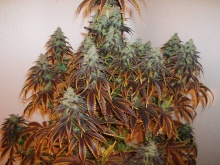List of psychoactive plants
This is a list of plants (flora) which contain psychoactive drugs. Psychoactive plants have been used traditionally for thousands of years by human cultures all around the world and many play a significant role in society. This list covers plants which are potentially psychoactive, while the list of entheogens covers plants which are known to be traditionally used as entheogens or psychoactives.
Contents
- 1 Psychoactive Flora by Family
- 1.1 Acanthaceae
- 1.2 Acoraceae
- 1.3 Aizoaceae
- 1.4 Apocynaceae
- 1.5 Aquifoliaceae
- 1.6 Asteraceae(Compositae)
- 1.7 Cactaceae
- 1.8 Cannabaceae
- 1.9 Caryophylloideae
- 1.10 Celastraceae
- 1.11 Convolvulaceae
- 1.12 Euphorbiaceae
- 1.13 Fabaceae (Leguminosae)
- 1.14 Fumariaceae
- 1.15 Lamiaceae
- 1.16 Lauraceae
- 1.17 Lythraceae
- 1.18 Magnoliaceae
- 1.19 Malpighiaceae
- 1.20 Myristicaceae
- 1.21 Nitrariaceae
- 1.22 Nymphaeaceae
- 1.23 Ochnaceae
- 1.24 Ochnaceae
- 1.25 Papaveraceae
- 1.26 Passifloraceae
- 1.27 Piperaceae
- 1.28 Poaceae (Gramineae)
- 1.29 Polygonaceae
- 1.30 Punicaceae
- 1.31 Rubiaceae
- 1.32 Rutaceae
- 1.33 Turneraceae
- 1.34 Urticaceae
- 2 See also
- 3 References
- 4 External links
Psychoactive Flora by Family
Acanthaceae
- Fittonia albivenis, a common ornamental plant from South America. The plant has unknown compounds, that reportedly cause "visions of eyeballs." It is also useful in the treatment of headaches, etc.
- Justicia pectoralis[1]
Acoraceae
Aizoaceae
- Delosperma acuminatum- DMT, 5-MEO-DMT[2]
- Delosperma cooperi - DMT, 5-MEO-DMT[2]
- Delosperma ecklonis - DMT[2]
- Delosperma esterhuyseniae - DMT[2]
- Delosperma hallii - 5-MEO-DMT[2]
- Delosperma harazianum - DMT, 5-MEO-DMT[2]
- Delosperma harazianum - Shibam, DMT[2]
- Delosperma hirtum - DMT[2]
- Delosperma hallii aff. litorale
- Delosperma lydenbergense - DMT, 5-MEO-DMT[2]
- Delosperma nubigenum - 5-MEO-DMT[2]
- Delosperma pageanum - DMT, 5-MEO-DMT[2]
- Delosperma pergamentaceum - Traces of DMT[2]
- Delosperma tradescantioides - DMT[2]
- Delosperma cooperi1.jpg
- M. Delosperma lydenbergense flower.JPG
- Delosperma nubigenum.jpg
Sceletium tortuosum or "Kanna" has been used by South African pastoralists and hunter-gatherers as a mood-altering substance from prehistoric times.
Apocynaceae
- Tabernanthe iboga - Ibogaine in root bark[3]
- Trachelospermum jasminoides - Ibogaine[4]
- Catharanthus roseus is (perhaps unpleasantly) "hallucinogenic."[5]
- Prestonia amazonica: DMT[6]
- Vinca minor
- Iboga.jpg
- Confederate Jasmine, Star Jasmine (Trachelospermum jasminoides).jpg
Aquifoliaceae
- Ilex guayusa, which is used as an additive to some versions of Ayahuasca. According to the Ecuadorian indigenous, it is also slightly hallucinogenic on its own, when drunk in high enough quantities.
- Ilex paraguariensis which is also known as "Yerba Mate"...
- Ilex vomitoria or "Yaupon Holly" is ...
and some other hollies are used as tea substitute stimulants!
Asteraceae(Compositae)
- Artemisia vulgaris - Thujone
- Calea zacatechichi - Produces vivid dreams after smoking. It is also employed by the Chontal people as a medicinal herb against gastrointestinal disorders, and is used as an appetizer, cathartic anti-dysentery remedy, and as a fever-reducing agent.
- Lactuca virosa - Lactucarium
- Tagetes lucida - Anethole, Chavicol, Coumarin, Estragole, Isorhamnetin, Methyleugenol, Quercitin
- ArtemisiaVulgaris.jpg
- Calea zacatechichi cutting.jpg
- Koeh-213.jpg
- Tagetes lucida flower.jpg
Cactaceae
| Species | Alkaloid Content (Fresh) | Alkaloid Content (Dried) |
| Echinopsis lageniformis(syn. Trichocereus bridgesii) | Mescaline > 0.025%,[7] also 3,4-dimethoxyphenylethylamine < 1%, 3-methoxytyramine < 1%, tyramine < 1% | 2%[8] |
| Echinopsis pachanoi(syn. Trichocereus pachanoi) | Mescaline 0.006-0.12%, 0.05% Average[9] | Mescaline 0.01%-2.375%[9] |
| Echinopsis spachiana(syn. Trichocereus spachianus) | Mescaline[10] | Mescaline[10] |
| Lophophora williamsii(Peyote) | 0.4% Mescaline[11] | 3-6% Mescaline[10] |
| Opuntia acanthocarpa | Mescaline[10] | |
| Opuntia basilaris | Mescaline 0.01%, plus 4-hydroxy-3-5 -dimethoxyphenethylamine[10] |
|
| Austrocylindropuntia cylindrica(syn. Opuntia cylindrica)[12] | Mescaline[10] | |
| Cylindropuntia echinocarpa(syn. Opuntia echinocarpa) | Mescaline 0.01%, 3-4-dimethoxyphenethylamine 0.01%, 4-hydroxy-3-5-dimethoxyphenethylamine 0.01%[10] | |
| Cylindropuntia spinosior(syn. Opuntia spinosior)[13] | Mescaline 0.00004%, 3-methoxytyramine 0.001%, tyramine 0.002%, 3-4-dimethoxyphenethylamine.[10] | |
| Echinopsis macrogona(syn. Trichocereus macrogonus) | > 0.01-0.05% Mescaline[14] | |
| Echinopsis peruviana(syn. Trichocereus peruvianus) | Mescaline 0.0005%-0.12%[9] | Mescaline |
| Echinopsis tacaquirensissubsp. taquimbalensis(syn. Trichocereus taquimbalensis)[15] | > 0.005-0.025% Mescaline[14] | |
| Echinopsis terscheckii(syn. Trichocereus terscheckii, Trichocereus werdemannianus)[16] | > 0.005-0.025% Mescaline[14] | Mescaline 0.01%-2.375%[9] |
| Echinopsis valida | 0.025% Mescaline[11] | |
| Pelecyphora aselliformis | Mescaline[11] |
- Echinopsis-pachanoi-close-up.jpg
- Lightmatter cactusflower.jpg
- Peyote Cactus.jpg
- Opuntia acanthocarpa.jpg
- Opuntia basilaris form.jpg
- Cylindropuntia echinocarpa 2.jpg
Cylindropuntia echinocarpa (syn. Opuntia echinocarpa)
- E.macrogona.png
- KK242 Vs Standard Peruvian Torch.jpg
- Echinopsis terscheckii 5.jpg
Cannabaceae
Template:Main Cannabis (Marijuana) is a popular psychedelic plant. Cannabis is also unique in that it contains a psychedelic substance, THC, which contains no nitrogen and is not an indole, phenethylamine, anticholinergic (deliriant), or a disassociative drug. Currently, certain universities and research firms are studying the medicinal effects of cannabis. Many jurisdictions have laws regulating the sale and use of medical cannabis to treat pain, seizures, insomnia, and to stimulate appetite.
Cannabinoid & Cannabis Studies, Documentaries & the like
Humulus lupulus http://en.wikipedia.org/wiki/Humulus_lupulus
Humulus japonicus- http://en.wikipedia.org/wiki/Japanese_hops
Caryophylloideae
|| 150px Silene capensis |Produces vivid dreams after ingesting.
Celastraceae
|| 150px Catha edulis | Khat
Convolvulaceae
| <center>D-lysergic acid amide and lysergic acid amides in the seeds; up to 0.12% total[17] | |
| Seeds contain D-lysergic acid amide, lysergol, and turbicoryn; lysergic acid alkaloids up to 0.03%[18] |

| 150px Argyreia nervosa (Hawaiian Baby Woodrose) |Seeds contain high amounts of LSA (also known as d-lysergic acid amide, d-lysergamide, ergine, and LA-111), often 50-150X the amounts found in Ipomoea violacea.
Euphorbiaceae
Fabaceae (Leguminosae)
| |
Up to 1.5% alkaloids, mainly consisting of tryptamine in leaf[19] |
| |
Active principles in leaf[20] |
| |
ß-methyl-phenethylamine[21], NMT and DMT in leaf (1.1-10.2 ppm)[22] |
| |
Tryptamine alkaloids.[23] Significant amount of tryptamine in the seeds.[24] |
| |
5-MeO-DMT in stem bark[25] |
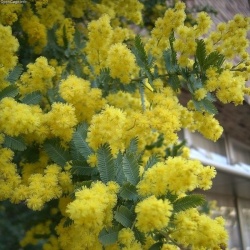 |
0.02% tryptamine and ß-carbolines, in the leaf, Tetrahydroharman[20][26][27] |
| <center>Acacia beauverdiana | Psychoactive[28] Ash used in Pituri.[29] |
| |
DMT, amphetamines, mescaline, nicotine[30] |
| <center>File:Koeh-003.jpg |
DMT[2] and other tryptamines in leaf, bark |
| <center>File:Acaciacaven29b.jpg |
Psychoactive[31] |
| |
DMT and other tryptamines in leaf, bark |
| |
DMT[32] |
| |
0.3% alkaloids in leaf and stem, almost all N-methyl-tetrahydroharman, with traces of tetrahydroharman, some of tryptamine[33][34][35] |
| |
DMT & NMT in leaf, stem & bark 0.04% NMT and 0.02% DMT in stem.[20] Also N,N-dimethyltryptamine N-oxide[36] |
| Psychoactive,[31] Tryptamines[37] | |
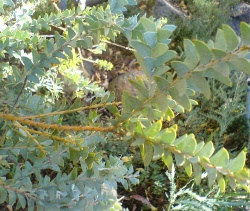 |
Tryptamine, in the leaf, stem[20] and seeds.[24] Phenethylamine in leaf and seeds[24] |
| |
Psychoactive[28] |
| |
Psychoactive,[31] but less than 0.02% alkaloids[27] |
| |
Psychoactive[28] |
| |
Psychoactive,[28] but less than 0.02% alkaloids[27] |
| Traces of 5-MeO-DMT[38] in fruit. ß-methyl-phenethylamine, flower.[39] Ether extracts about 2-6% of the dried leaf mass.[40] Alkaloids are present in the bark[41] and leaves.[42] Amphetamines and mescaline also found in tree.[37] | |
| |
Tryptamine, phenethylamine,[43] in flowers[24] other tryptamines,[44] |
| |
Psychoactive,[31] plus deadly toxins |
| Psychoactive[31] | |
| |
Psychoactive[45] |
| |
DMT, NMT |
| |
Psychoactive |
| |
DMT, in the leaf[20] |
| |
0.2% tryptamine in bark, leaves, some in flowers, phenylethylamine in flowers,[43] 0.2% DMT in plant.[46] Histamine alkaloids.[27] |
| |
Tryptamine in leaves, bark[24] |
| |
Tryptamine[24] |
| |
0.6% NMT and DMT in about a 2:3 ratio in the stem bark, both present in leaves[20] |
| |
Psychoactive[31] |
| |
DMT, in the bark and leaf,[47] but less than 0.02% total alkaloids[27] |
| DMT, in the leaf[20] | |
| |
DMT, in the leaf[20] |
| |
Psychoactive, DMT in the leaf |
| |
Tryptamine, DMT, NMT, other tryptamines,[45] 0.4-0.5% in dried bark, 0.07% in branch tips.[48] |
| |
Less than 0.1% DMT in leaf,[26][49] NMT |
| |
Psychoactive[28] |
| |
0.3% DMT in leaf, NMT[20] |
| |
Tryptamine in the leaf,[20] 0.5% to 2% DMT in fresh bark, phenethylamine, trace amounts[43] |
| |
DMT in leaf[20] and other tryptamines in leaf, bark |
| |
Less than 0.2% DMT in leaf, NMT; DMT and other tryptamines in leaf, bark[50] |
| |
DMT, NMT, tryptamine, traces of amphetamines, mescaline, nicotine and others[51] |
| |
Psychoactive[31] |
| |
ß-methyl-phenethylamine, Phenethylamine[52] Amphetamines and mescaline also found.[37] |
| |
Less than 0.1% DMT in leaf,[20] NMT, other tryptamines. DMT in plant,[39] DMT in bark.[24] |
| |
DMT, in the leaf.[20] Ether extracts about 1-7% of the dried leaf mass.[40] |
| |
DMT, in the leaf[20] |
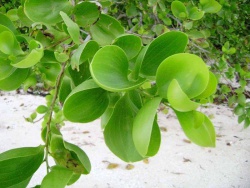 |
DMT and NMT, in the leaf, stem and trunk bark, 0.81% DMT in bark, MMT[20][53] |
| |
DMT, NMT, and other tryptamines[45] |
| |
Tryptamine, in the leaf and stem,[20] but less than 0.02% total alkaloids[27] |
| |
Tryptamines, 5-MeO-alkyltryptamine[24] |
- Albizia inundata leaves contain DMT.[31]
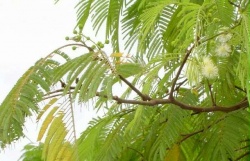 |
|
| |
Bufotenin and Dimethyltryptamine have been isolated from the seeds and seed pods, 5-MeO-DMT from the bark of the stems.[56] The seeds were found to contain 12.4% bufotenine, 0.06% 5-MeO-DMT and 0.06% DMT.[57] |
| |
|
| |
Bufotenine is in the seeds.[59] |
| 0% - 0.34% DMT in root bark, highly variable.[60] Also NMT, N-hydroxy-N-methyltryptamine, 2-hydroxy-N-methyltryptamine, and gramine (toxic).[61] | |
| |
0.14% DMT in root bark, more reliable than D. illinoensis[60] |
| |
Roots: 0.087% DMT,[63] Bufotenine-N-oxide 0.03% |
| |
DMT, 5-MEO-DMT, whole plant, roots, stems, leaves[64] |
| |
Bufotentine, DMT[65] |
| |
DMT, 5-MEO-DMT, leaves, roots[64] |
| |
5-MEO-DMT[64] |
| |
0.0004% DMT-N-oxide, roots,[63] less in stems[63] and trace in leaves.[63] |
| |
|
| |
DMT, 5-MEO-DMT in leaves and roots[66] |
| |
DMT, 5-MEO-DMT in leaves and root bark[64] |
| |
Dried root: DMT 1.6%, NMT 0.0012% and hordenine 0.0065%[67] |
| |
Tryptamine, NMT, DMT and N-methyltetrahydrocarboline in bark[68] |
| |
Trytamines and MMT |
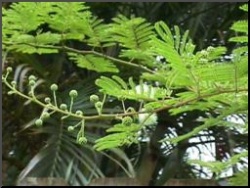 |
0.31-0.57% DMT (dry root bark).[69] |
| |
DMT[70] in root bark |
| |
"The leaves, seeds, stems and roots contain L-Dopa, Serotonin, 5-HTP, and Nicotine, as well as N,N-DMT, Bufotenine, and 5-MeO-DMT."[71] |
| |
0.4-0.5% tryptamine, DMT, etc. in leaves and stems[66] |
| |
DMT in leaves and stems[64] |
| |
0.2% 5-MeO-DMT, small quantities of DMT[66] DMT (dominates in seedlings and young plants), 5-MEO-DMT (dominates in mature plant), whole plant, roots, stems, leaves, flowers[64] |
Erythrina flabelliformis, other Erythrina species, seeds contain the alkaloids Erysodin and Erysovin[72]
|| 100px Zornia latifolia | Zornia latifolia, is mentioned in Food of the Gods as "an hallucinogenic substitute for cannabis". It's nicknamed Maconha brava because locals use it as a cannabis substitute. |-
Caesalpinioideae subfamily of Fabacaeae
- Petalostylis cassioides: 0.4-0.5% tryptamine, DMT, etc. in leaves and stems[73]
- Petalostylis labicheoides, Tryptamines in leaves and stems, MAO's up to 0.5%[74]
Fumariaceae
|| 150px Corydalis solida, Corydalis cava | Bulbocapnine, Nantenine, Tetrahydropalmatine
Lamiaceae
|| 150px Lagochilus inebrians | Lagochilin is thought to be responsible for the sedative, hypotensive and hemostatic effects of this plant.
|| 150px Leonotis leonurus |Both leaves and flowers (where most concentrated) contain Leonurine. (Effects reminiscent of marijuana)
| 150px
Salvia divinorum
| Salvinorin A, 0.89-3.87 mg/g, also Salvinorin B and Salvinorin C[75]
|-
Lauraceae
Lythraceae
- Heimia salicifolia, auditory[76]
Magnoliaceae
150px Magnolia virginianaThe leaves or bark have been placed in cupped hands over the nose and inhaled as a mild hallucinogen
Malpighiaceae
- Banisteriopsis caapi: Ayahuasca
- Diplopterys cabrerana: DMT 0.17-1.74%, average of 0.47% DMT[77]
Myristicaceae
- Horsfieldia superba: 5-MeO-DMT[66] and beta-carbolines[73]
- Iryanthera macrophylla: 5-MeO-DMT in bark[66]
- Iryanthera ulei: 5-MeO-DMT in bark[64]
- Osteophloem platyspermum: DMT, 5-MeO-DMT in bark[64]
Virola genus
| Virola calophylla | Leaves 0.149% DMT, leaves 0.006% MMT[64] 5-MeO-DMT in bark[78] |
| Virola callophylloidea | DMT |
| Virola carinata | DMT in leaves[64] |
| Virola cuspidata | DMT[74] |
| Virola divergens | DMT in leaves[64] |
| |
DMT, 5-MEO-DMT in bark, roots, leaves and flowers[64] |
| Virola melinonii | DMT in bark[64] |
| Virola multinervia | DMT, 5-MEO-DMT in bark and roots[64] |
| Virola pavonis | DMT in leaves[64] |
| Virola peruviana | 5-MEO-DMT, traces of DMT and 5-MeO-tryptamine in bark[64] |
| Virola rufula | Alkaloids in bark and root, 95% of which is MeO-DMT[79] 0.190% 5-MeO-DMT in bark,[64] 0.135% 5-MeO-DMT in root, 0.092% DMT in leaves.[64] |
| Virola sebifera | The bark contains 0.065% to 0.25% alkaloids, most of which are DMT and 5-MeO-DMT.[80] |
| Virola surinamensis | DMT[74] in bark[64] |
| Virola venosa | DMT, 5-MEO-DMT in roots, leaves[64] DMT |
Nitrariaceae
</li>
Nymphaeaceae
| 150px Nymphaea caerulea |Recent studies have shown Nymphaea caerulea to have psychedelic properties, and may have been used as a sacrament in ancient Egypt and certain ancient South American cultures. Dosages of 5 to 10 grams of the flowers induces slight stimulation, a shift in thought processes, enhanced visual perception, and mild closed-eye visuals. Nymphaea caerulea is related to, and possesses similar activity as Nelumbo nucifera, the Sacred Lotus. Both Nymphaea caerulea and Nelumbo nucifera contain the alkaloids nuciferine and apomorphine, which have been recently isolated by independent labs.Template:Citation needed
These psychoactive effects make Nymphaea caerulea a likely candidate (among several) for the lotus plant eaten by the mythical Lotophagi in Homer's Odyssey.
Used in aromatherapy, Nymphaea caerulea is purported to have a "divine" essence, bringing euphoria, heightened awareness and tranquility.Template:Citation needed
Other sources cite anti-spasmodic and sedative, purifying and calming properties.
|Ochnaceae
- Testulea gabonensis: 0.2% 5-MeO-DMT, small quantities of DMT,[66] DMT in bark and root bark[64], NMT
Ochnaceae
Genus Pandanus (Screw Pine): DMT in nuts[66]
Papaveraceae
The most famous member of this family is the Opium poppy.
|| 100px Argemone mexicana | Used by Chinese residents of Mexico during the early 20th century as a legal substitute for opium and currently smoked as a marijuana substitute.
| 150px Glaucium flavum | Glaucine
Passifloraceae
Piperaceae
|| 150px Piper methysticum | Kavalactones
Poaceae (Gramineae)
Some Graminae (grass) species contain gramine, which can cause brain damage, other organ damage, central nervous system damage and death in sheep.[83]
| Species | |
| | |
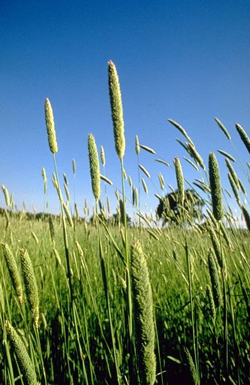 |
|
| |
|
| |
|
| |
|
None of the above alkaloids are said to have been found in Phalaris californica, Phalaris canariensis, Phalaris minor and hybrids of P. arundinacea together with P. aquatica.[85]
Polygonaceae
Punicaceae
- Punica granatum "DMT in root cortex;"[74] The dried stem and root bark of the tree contain about 0.4-0.9% alkaloids.[87]
Rubiaceae
Mitragyna speciosa also known as "Kratom" is a plant which leaf is used for it's opiod effect.150px
| |
|
| |
|
| |
|
| |
|
| |
|
| |
|
| |
|
| |
|
| |
|
Rutaceae
| |
|
| |
|
Turneraceae
|| 150px Turnera diffusa | Damianin
Urticaceae
- Urtica pilulifera: Bufotenin[74]
See also
- Aztec entheogenic complex
- Entheogenic drugs and the archaeological record
- List of Entheogens
- List of poisonous plants
- List of plants containing beta-carbolines
- List of plants used for smoking
- Louisiana State Act 159
- Psilocybin mushrooms
- Psychoactive animals
References
External links
- The Salvia Divinorum Blog Research And Information
- The Salvia Divinorum Mass Distribution Project
- Descriptions of psychoactive Cacti. Lycaeum Visionary Cactus Guide
- "Herbal Highs - Legal Buds Reviews" Components of street drug alternatives sold and used legally.
- Erowid Tryptamine FAQ -- More Plants Containing Tryptamines
- John Stephen Glasby, Dictionary of Plants Containing Secondary Metabolites, Published by CRC Press
- Golden Guide to Hallucinogenic Plants
- Hallucinogens on the Internet: A Vast New Source of Underground Drug Information John H. Halpern, M.D. and Harrison G. Pope, Jr., M.D.
- Peter L. Katavic, Chemical Investigations of the Alkaloids From the Plants Of The Family Elaeocarpaceae, School of Science/Natural Product Discovery (NPD), Faculty of Science, Griffith University
- Alexander T. Shulgin, Psychotomimetic Drugs: Structure-Activity Relationships
- UNODC The plant kingdom and hallucinogens (part II)
- UNODC The plant kingdom and hallucinogens (part III)
- Virola -- Dried Herbarium Specimens
- Virola Species Pictures -- USGS
- Desmanthus illinoensis -- USDA
- A General Introduction to Ayahuasca
- Psychedelic Reader (Google Books)
Cite error: <ref> tags exist, but no <references/> tag was found
